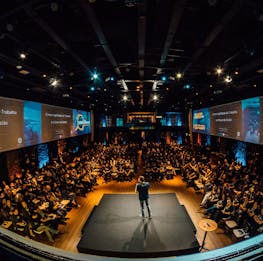Do you ever feel anxious and inundated by all of the incomplete tasks hanging over you?
Getting Things Done, gives us a system for organizing and managing all the to-dos that threaten to overwhelm us. David Allen's timeless and trustworthy insights give us five steps to master workflow, boost productivity, and reduce stress.
Allen is a productivity consultant who developed the "Getting Things Done System" in 2011. He has global acclaim for his work on self-management and productivity. Through this work, he has coached some of the brightest and busiest people around.
We'll briefly look at the Getting Things Done System that transforms productivity into an art form. David Allen knows that most of us are overwhelmed by heavy workloads. This book shares some simple and practical tips on what's been proven to help Allen's clients. In short, this is the ultimate guide to getting things done.
In Today’s World, it’s Easy to Feel Frantically Busy
Have you ever wondered what you'd do if you had an extra two hours per day? You may think that you'd use these extra hours to be incredibly productive, but David Allen disagrees. He asserts that they'd probably be another two hours of distraction-filled time. The key to managing our workload isn't actually by giving ourselves more time. Rather, It's about increasing our mental bandwidth, which is our space to think about the task at hand. The author says that our minds are great at generating ideas, rather than holding on to them. So, we need a way to capture and remember tasks. To do this, we need to understand the principles behind this process.
Allen admits there's no silver bullet for perfecting organization and productivity. We also don't need more tools to increase productivity. Instead, we need a reliable process to clear our minds. These processes will allow us to engage fully with what we do. He further argues that: 'Getting things done isn't actually about getting things done—it's about cultivating an engaged presence.'
An Engaged Presence, Enables Productive Doing
When was the last time you were in a state of flow? Flow is a state where you have a wonderful sense of calmness, clarity, and creativity. We need to get strategic when it comes to managing our projects and ticking off our to-dos. The first step is to clarify our intended outcomes and then decide on the action steps we need to do, to complete a task successfully.
Allen argues that the more something is on our minds, the less we're doing about it. Until we clarify our thoughts and capture them in a system we trust, our minds won't rest. We focus too much on things that aren't resolved. And, this fixation diminishes our work performance. These are what the author calls open loops. Psychological research shows that a significant part of our psyche cannot help but track open loops. It's like having multiple programs open on your computer. As we know, too many open programs, can slow down the entire system. So, how do we organize our minds to maximize productivity?
To Clear Our Minds, We Need to have Clarity About What Needs to be Done
Knowing what to do and how to do it, is far from self-evident in our contemporary working world. We're in a paradoxical age. The quality of our lives may have improved, but we're stressed, and we often complain about time famine. Comparing our lives to previous generations, we face a new set of unique challenges. In the past, work was far more self-evident. Fields needed plowing, machines required fixing, and perhaps we had to milk some cows. We knew exactly what we needed to do, and when it needed to be done by. Prioritizing was so much easier, when we could see the tasks right in front of us. Nowadays, our jobs and lives are in constant flux. Because of this flux, we need a reliable organizational process to track our ever-changing reality.
In his seminars, the author often asks his audience, who of them are doing what they were hired to do. He notes that it is seldom that anyone raises their hand.
For those of us who are knowledge workers, there are no boundaries to most of our projects. Most of the time, when it comes to projects, we have to establish what we need to do, and when we need to complete it. And the problem is that, almost every project can be improved or tweaked. Furthermore, technological advances mean that we have infinite information on how to do things better, all right at our fingertips.
Our projects are more poorly defined than ever before. Our jobs, and lives, are continually changing.
The author also often asks his seminar audiences, how many of them have not had any changes in their personal lives or careers within the last year. Again, few audience members ever raise their hands. Even if our jobs are constant, changes happen in our relationships, health, and finances. Research suggests that in the past seventy-two hours, we have received more change-producing, project-creating, and priority-shifting inputs than our parents did in a month, or maybe even in an entire year.
Yet, despite all of these changes and factors, most of us don't have an effective way to organize our lives systematically. For the majority of us, we lack a clear framework from which to work. Our daily to-do lists, and priority codes, are inadequate to deal with our workload's volume and variation.
According to David Allen, the typical to-do lists include items like: Mom, Bank, Doctor, and maybe even Babysitter. He says that most to-do lists just collect seemingly random stuff. They're only partial reminders of many unresolved things, rather than items that have clear outcomes and actions. These unclear lists are not controllable. The less in control we feel, the more unproductive we become.
The trend is towards big-picture thinking, because the argument is that by clarifying our values and overarching goals, our work gains meaning and direction. The author feels that we're so distracted, that it's challenging to focus on big picture thinking.
Big-picture thinking can make us feel overwhelmed, so he proposes a system that works from the ground up. David Allen suggests that there is a need for both big picture thinking, with a focus on the small details. He says we need to make things easier to get things done. So, he developed a five-step process.
To begin the process, we need to develop a method that'll enable us to be fully engaged in what we're doing. We need to clear the deck, so that we can make some real progress. The author suggests that to maximize his five-step process's benefits, we need to cancel any commitments and clear space for unbroken time to do our initial planning. Then, we find a quiet, functional workspace that is our own. Even if that workspace is just a small writing surface and an in-tray. After this, the author suggests choosing helpful tools such as basket trays, sticky notes, electronic notes, or email. The idea is to create a digital, or paper-based reference filing system. Once we have done the initial planning, we can roll up our sleeves and begin with the five-step process.
The five-step process towards achieving stress-free productivity is to: Collect, Clarify, Organize, Review, and finally Do.
Step 1: Collect
Step one is adopting the inbox system. Inboxes may not be a new idea, but we need to be disciplined about collecting everything that's demanding our attention. Gathering everything that we need to get done, also gives us an idea of the volume of tasks we have.
Once we know that an item is stored safely in our inbox, the psychological distraction it causes will decrease. If you're busy with another task and suddenly remember something else you need to do, simply drop a note in your inbox. After that, you can forget about it.
The author suggests that we need to include as much information in our inbox for larger tasks as possible. This information includes reference materials, equipment, and any decoration.
We need to write down whatever is buzzing around in our minds, on separate sheets of paper. Write down all the things that need attention, and add them to the inbox. Don't worry if these ideas aren't fully formed - they only need to be captured and released from our minds.
Next, we can move onto stage two, which involves clearing out our inbox.
Step 2: Clarify
Processing your inbox can be a daunting process. We need to ask ourselves some questions to start making progress. When dealing with a task from your inbox, you need to ask yourself what's next for this item, and whether you want to act on it. If you don't need to act on it, you can take three possible actions: trash it, incubate it, or reference it.
A fun idea for incubating a task is creating what David Allen calls a "someday maybe" folder. This folder is where you can store passion projects, ideas for holidays, or anything that you might want to act on in the future. Creating a reference folder allows you to immediately file away any tasks you may want to act on, such as recipes or interesting articles.
If you decide that you need to act on a task, you need to determine two things. The first thing is identifying what you've committed to. The second is deciding what action step is required? Doing this will allow you to create a project list.
Step 3: Organize
Organizing can involve drafting thoughts for a budget-meeting agenda, calling someone about a recommendation, or asking someone to set up a filing system. Getting organized involves streamlining. The easiest way to streamline tasks is to determine whether the task or action will take less than 2 minutes to do.
If you can complete the action in less than 2 minutes, then do it. If it's going to take longer, then decide if you can delegate or defer it to tackle later. If you've delegated, or are waiting on something, then put it on a follow-up list. Creating a calendar or follow up list is an easy way to get organized.
Organizing is essential, and we need distinct categories to store information. These categories include: a projects list, calendar actions, new plans, a waiting-for list, and additional information we want to reference. All of these categories may seem complex, and perhaps a little overwhelming. However, once you get the hang of it, it'll be a breeze.
Step 4: Review
Having a review system is crucial to keeping your system functional. It's essential to look over all outstanding projects, at least once a week. In the GTD system, this is called the weekly review.
Reviewing tasks and actions allows us to monitor progress, and to mark off our completed items. Reviewing tasks also enables us to scan for upcoming appointments and capture any details from the previous week. This review may also be an opportunity to follow up on anything that needs attention, or looking over incomplete projects.
The point of collecting, processing, organizing, and reviewing is to get to the final step, the 'do it' step. This step involves making the most appropriate action choices.
Step 5: Do It
Completing a task relies on four factors: context, time, energy, and priority. There are very few activities that we can do anywhere. Context and location limit us. Therefore, it's imperative to consider how to action a task in a given context, and what tools we may need to complete it.
Then there's the issue of time. When do we have to do something else, or be somewhere else? If we have a meeting in five minutes, this limits us from taking actions that will take longer. Furthermore, how much energy do we have? Some activities require a fresh reservoir of creative mental energy. Some need very little.
Given the context, the time, and your available energy, you need to ask yourself what action will have the highest payoff? For example, if we're at our office desk, with an hour to work, and our energy is seven out of ten, what do we prioritize? Should we call a client, work on a proposal, or process emails? Carefully considering these questions will help us to feel comfortable that we're doing the right thing, at the right time, in the right way.
In Conclusion
Getting Things Done refines the art of productivity. As with any art form, it takes a while to learn, and it may feel daunting. Initially, the process may feel overly complicated, awkward, and unnecessary. However, if you stick with the process, it'll enable you to be more productive and to alleviate a lot of stress and anxiety. Procrastination is something everyone battles with at some point or another. Hence, the purpose of David Allen's book is to provide the big picture we all need, namely a 'road map to achieve the positive and relaxed focus that characterizes our most productive state.'
Furthermore, he gives us the fine details to entrench the process to feel less overwhelmed and more productive. Ultimately, we don't need more hours in a day; we just need to get things done.




